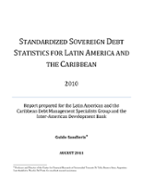Standardized Sovereign Debt Statistics for Latin America and the Caribbean: 2010
Date
Jan 2010
This report updates data on gross and net public debt for countries in the Latin America and Caribbean (LAC) region up to June and December 2010. Gross public debt refers to the total debt of the central government and the central bank, excluding the latter's monetary liabilities and its short-term debt issued for the purpose of monetary regulation. Net public debt subtracts from the previous amount, Central Banks holdings of public debt and international reserves.The data in this report was collected from questionnaires sent to the LAC countries debt offices in April 2011. A record twenty-three countries completed the questionnaire for this report. These countries were: Argentina, The Bahamas, Bolivia, Brazil, Chile, Colombia, Costa Rica, Dominican Republic,
Ecuador, El Salvador, Guatemala, Haiti, Honduras, Jamaica, Mexico, Nicaragua, Panama, Paraguay, Peru, Suriname, Trinidad & Tobago, Uruguay and Venezuela.
This report is organized as follows. Section 1 summarizes the new developments regarding public debt during 2010. It also presents summary cross country tables for relevant variables. Section 2 displays, in a nutshell, basic information on sovereign debt level and composition by country, as well as information on benchmark bonds and the most recent debt issuances. Section 3 shows more detailed country data in the Data Tables. Finally, the Methodological Appendix in Section 4 describes the debt concepts included in
this report, and attaches the questionnaire sent to each country debt office to gather the data.
Ecuador, El Salvador, Guatemala, Haiti, Honduras, Jamaica, Mexico, Nicaragua, Panama, Paraguay, Peru, Suriname, Trinidad & Tobago, Uruguay and Venezuela.
This report is organized as follows. Section 1 summarizes the new developments regarding public debt during 2010. It also presents summary cross country tables for relevant variables. Section 2 displays, in a nutshell, basic information on sovereign debt level and composition by country, as well as information on benchmark bonds and the most recent debt issuances. Section 3 shows more detailed country data in the Data Tables. Finally, the Methodological Appendix in Section 4 describes the debt concepts included in
this report, and attaches the questionnaire sent to each country debt office to gather the data.



